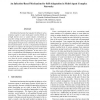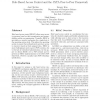307 search results - page 9 / 62 » A Network Access Control Mechanism Based on Behavior Profile... |
SASN
2006
ACM
14 years 1 months ago
2006
ACM
Wireless sensor networks are typically deployed to measure the information field, rather than create an information field. However, by utilizing the radio on sensor nodes, it is...
DBSEC
2010
13 years 9 months ago
2010
Abstract. Access control mechanisms are used to control which principals (such as users or processes) have access to which resources based on access control policies. To ensure the...
SASO
2008
IEEE
14 years 2 months ago
2008
IEEE
Resource management for ad hoc grids is challenging due to the participation of heterogeneous, dynamic, autonomous and ephemeral nodes. Different underlying network infrastructure...
SASO
2008
IEEE
14 years 2 months ago
2008
IEEE
Distributed mechanisms that regulate the behavior of autonomous agents in open multi-agent systems (MAS) are of high interest since we cannot employ centralized approaches relying...
CSREASAM
2006
13 years 9 months ago
2006
Role based access control (RBAC) allows users access to resources based on their competencies and responsibilities within an organization. Typically, RBAC is provided as a securit...


